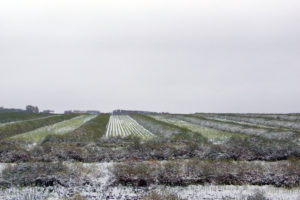Confusing weather patterns define 2018 crop year
Agricultural chronicles may look back at 2018 crop year as a period witnessing one of the most interesting weather patterns experienced in a single year in Alberta.
In the course of the seeding and growing seasons, serious concerns occupied producers’ minds for different reasons at different times: Early spring was wet with 
By the end of October, however, the final Crop Report for 2018 issued by Alberta Agriculture and Forestry said nearly 95 per cent of annual crops had been loaded to the bin, with the last week of October alone accounting for 17 per cent progress in harvest, thanks to warmer than average temperatures.
Overall, the fluctuating weather appears to have impacted mostly perennial crops while annual crops, particularly in the southern and central areas of the province, also suffered both quality losses and production shortfalls.
Reflected in figures, the dry conditions during late spring and through the summer led to an increase in claim rates on pasture subscriptions under the Moisture Deficiency Insurance (MDI) and Satellite Yield Insurance (SAT) programs. In 2018, 3,097 MDI subscriptions from the total of 3,565 received indemnity payments. Indemnity claims for MDI were 2,257 in 2017 and only 436 in 2016. SAT indemnity figures of 2018 (327 claims out of 402 subscriptions), on the other hand, did not show a big discrepancy as compared to 2017 figures (410 claims out of 441 subscriptions) but were substantially higher than 2016 numbers (76 of 480 subscriptions).
Total perennial crop post-harvest claims for hay and export timothy hay in 2018 rose to 805 from 425 in 2017, almost a two-fold increase.
The dry and hot spell of June-August period also led some annual crop producers to decide to put their crops to a use other than harvesting, thereby increasing the demand for preharvest inspections of the fields that needed to be released by AFSC for alternative uses. As a result, field inspections by AFSC staff in 2018 crop year rose to 2,088* from 1,325 in 2017, but this figure was still below the 2015 and 2016 statistics, 2,639 and 2,526, respectively.
In contrast, the beginning of the same hot and dry spell improved seeding conditions and led to a decline in unseeded acreage benefit claims due to excessive moisture. The number of those claims fell from 3,100 in 2017 to 1,300 in 2018, less than half of the previous year.
Hail claims of 2018 didn’t show any noticeable difference from the 2017 levels, with straight hail and hail endorsements totalling 5,300 in 2018 as compared to 5,260 in 2017, but remained significantly lower than the number of 2016 claims at 9,290.
Similarly, post-harvest indemnity claims for annual crops in 2018 were slightly different from the 2017 figures, 3,474* and 3,750, respectively, but they were noticeably lower than 4,600 claims of 2016.
As for unharvested acreage benefit claims, resulting from the early October snow particularly in the Central Area, 2018 saw slightly higher numbers than in 2017, 220 by mid-December 2018 versus 189 in 2017, but both figures remained just a fraction of the 2,255 unharvested acreage claims of 2016.
* As of mid-December 2018
